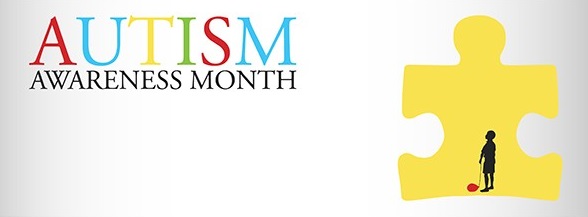April is Autism Awareness Month
Each year on April 2, World Autism Awareness Day, iconic buildings across the world turn their lights blue to promote autism awareness for the whole month of April. The awareness of autism spectrum disorder is continuing to increase and luckily support networks are in place for people who have been diagnosed as well as their families. Below we have gathered some information which we feel would be valuable to anyone in contact with a child that has autism or simply wishes to know more about autism and how to help. Please be mindful that each and every child with autism has their own unique challenges.
What is Autism?
When people refer to “Autism” today, they are usually talking about Autism Spectrum Disorders (ASD), which can impair social interaction and communication. Children with ASDs might have unusual ways of learning, paying attention, and reacting to different sensations. Every child on the spectrum has unique abilities, symptoms and challenges. This is why the word ‘spectrum’ is used. Sensitivity to the environment around them is another common symptom. Each sense can be either over sensitive or under sensitive and this can change daily or throughout the day.
Autism in the Classroom
It is important to realize, like any other child, each child with autism is different from the other. Each child has their own way of seeing the world, which makes each child with autism unique. This means that, just because strategies that have been used and have worked for one child with autism, may not work for the next child who is on the spectrum. Here is a list of ideas to help create a supportive learning environment for children with autism.
Try to learn as much as you can about the child – Find out special interests and possible obsessions, as this can be a valuable teaching tool and will help interacting with the child.
Routines and schedules – As with any child, creating a predictable routine give a child confidence, independence and reduces anxiety. This can be especially important with a child on the spectrum. In a classroom setting using a visual schedule can assist with successful transitions between activities. Using a timer to give a time warning can also be helpful.
Visual supports – Research shows that children with autism have visual strengths. Use visual strategies to improve their understanding and positive interactions with learning. Where possible, include visual images when teaching.
Social skills and educating others – Children with autism need support in social situations. Creating such opportunities will help interaction. For example, provide an organized environment with a small group of children who are provided with a structured activity. Teach specific social rules and skills, such as, turn taking and personal space. Educating children that are not on the spectrum about the challenges a child with autism faces will help develop awareness, acceptance, tolerance and friendships.
Communication is crucial – Many children with autism find it difficult to pay attention and follow instructions. Keeping language simple and concrete is important. It is best to get the point across in as few words as possible. Repeat instructions if necessary and always address the child by their name and check for understanding. Most importantly, give positive feedback when the child responds.
Understand behaviors – Gain knowledge about the child and information on what may upset them. Having a handful of strategies to calm the child down, if their behavior is escalating is important. Children with autism often seek sensory activities such as flapping, twirling or rocking to help calm their anxiety. Using a sensory toy can improve their behavior.
Achievable goals, feedback and rewards – It is important to give a child with autism achievable goals to work towards. Giving them at least one familiar aspect will reduce stress. Celebrate even the smallest of successes. Choose rewards that are functional, concrete and capable of immediate sensory feedback. Compiling a list of rewards will be helpful to know what motivates the child.
Limit choices, give instructions – By reducing choices, you will find children with autism engage more quickly in activities. For example, if a child on the spectrum is told to choose a toy from the bin, they may find that overwhelming. If, instead, you give them two toys to choose from, they are more likely to engage in the play. Also, giving instructions rather than asking them a lot of questions can more easily engage them. For example telling them to bring you a book you can read together instead of asking if they would like to read a book, or which book they would like to read.
Autism And Successful Birthday Parties
The Peer Party
As a parent to a child on the spectrum, you may get invites from kids in daycare, preschool, the neighborhood, etc. Below find some factors to consider especially if you aren’t as familiar with the family.
Get to know them and the circumstances – Contact the host and try to get a better sense of what the party will entail. Will there be an activity that you know your child is afraid of? How many children are expected? What kind of food will be served? Having this information ahead of time is crucial in planning for success but also making the decision if this might be too overwhelming for your child.
Social Stories – Review ahead of time what is going to happen. Prepare the child for loud singing, presents that will be opened (that won’t be theirs!), taking turns on the playground equipment, etc. Read or tell the story many times before attending the party. Trying to prepare as much as possible is important.
Food – To know what kind of food will be served at the party will allow you to pack snacks or food your child will eat. Alert the host ahead of time, they might be unfamiliar with your child, and may be offended if they think your child chose to eat other food.
Overstimulation – Kid’s parties can be one of the most over stimulating events ever! Some adults are overwhelmed by the thought of a small space with 30 screaming, sugar happy children. Now imagine this for a sensory sensitive child. To know ahead of time if there might be an escape, such as a quiet room if needed, will be good information to have to make an informed decision on whether to attend the party.
Advocate – It is a personal decision on if and how to discuss your child and what information to share. Let the host know what may be hard for your child and that you may not stay for the whole party ahead of time. Educating others is the first step in a long road to acceptance but it is important when others tend to make assumptions regarding behavior they see.
Autism And Successful Birthday Parties
Your Child’s Party
This is supposed to be a fun day to celebrate your little one. You cannot avoid every potential problem but you can try to steer clear of as many as possible.
The Guest List – Take the number of people and their familiarity with your child into consideration. Sometimes grandparents, aunts, uncles and cousins can be enough. Always try to think of it from your child’s point-of-view. What amount of people and who would make it a positive day for them?
Location – Where is the best place to have the birthday party? Sometimes home parties are more comfortable and predictable than other locations with typically less unwelcome surprises. Some children are perfectly capable of handling a bounce venue – you know your child best- so individualize the party location for their wants and interests.
Visual Schedules – You can not plan everything perfectly ahead nor is planning a guarantee that everything will go according to plan. However, figuring out the sequence of events ahead of time and reviewing it with your child prior to the party might make a difference. The use of pictures, objects or a list of activities; can help with understanding expectations. These tools can also be used during the party. To bring them out to keep reviewing what is going to happen next might help.
Social Stories – As with peer parties, try to review any difficult situations in story format before the party. (This includes talking about the attendees, what events will occur and other things he/she should expect).
To Sing or Not to Sing – The “Happy Birthday” song has left many children in tears. This is again based on your child’s individual case. Some parents don’t know until they try. Preparation can make a huge difference; the unexpected might be the bigger issue sometimes when singing to the birthday boy or girl.
Educate & Advocate – Recognize that some people may not be adequately educated about autism, sensory processing disorder or other spectrum diagnoses. This might be a good opportunity to educate and advocate. Before the party, sit down with any individuals that may need help recognizing why certain behaviors occur and what the underlying issues may be.







